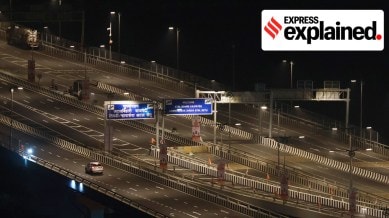Mumbai Trans Harbour Link inaugurated: How the country’s longest sea bridge will cut travel time
Officially called the Atal Setu Nhava Sheva Sea Link, the bridge that was first conceptualised six decades ago will cut the travel time between Sewri and Chirle to under 20 minutes.

On Friday, Prime Minister Narendra Modi inaugurated the country’s longest bridge over the sea, the 22 km Mumbai Trans Harbour Link, officially the Atal Setu Nhava Sheva Sea Link. The bridge that was first conceptualised six decades ago will cut the travel time between Sewri and Chirle to under 20 minutes.
The new sea link
The Mumbai Trans Harbour Link (MTHL) is a 22-km-long twin-carriageway six-lane bridge over the Thane Creek in the Arabian Sea, connecting Sewri in the island city of Mumbai to Chirle in Raigad district on the mainland.
The MTHL includes a 16.5 km sea link and viaducts on land at either end with a cumulative length of 5.5 km.
The objective of the project is to improve connectivity in the Mumbai Metropolitan Region which comprises the districts of Mumbai, Thane, Palghar, and Raigad, and promote the region’s economic development. The MTHL will bring Mumbai and Navi Mumbai closer by dramatically cutting travel time, and will decongest the existing route over the Vashi bridge.
From 1963 to 2024
The idea of a bay crossing connecting Mumbai to the mainland was first floated in 1963 by the American construction consultancy firm Wilbur Smith Associates, but no follow-up action was initiated. The plan was revived in the late 90s, and the first tenders were floated in 2006.
In February 2008, Anil Ambani’s Reliance Infrastructure emerged as the preferred bidder after promising to build and recover the cost of building the (then) Rs 6,000 crore bridge in nine years and 11 months through a public private partnership (PPP) model.
Months later, however, Ambani withdrew from the project. Multiple unsuccessful bidding processes followed, and the nodal agency was changed from the Maharashtra State Road Development Corporation (MSRDC) to the Mumbai Metropolitan Region Development Authority (MMRDA).
The project finally got moving after MMRDA entered into an agreement with Japan International Cooperation Agency (JICA), which agreed to fund 80 per cent of the project cost, with the rest being borne by the state and central governments.
The deal and tendering were finally completed in December 2017, and work commenced in early 2018. A total Rs 21,200 crore has been spent on the project, of which Rs 15,100 is loan from JICA.
How MTHL will help
* According to a study conducted by MMRDA and JICA, the MTHL will bring down the average travel time between Sewri and Chirle from 61 minutes currently to less than 16 minutes. Close to 40,000 vehicles are expected to use the link every day in the opening year (2024).
* The project is expected to facilitate greater economic integration of Navi Mumbai with Mumbai, with benefits extending to Panvel, Alibaug, Pune, and Goa.
* It will very significantly improve connectivity between South Mumbai and the under-construction Navi Mumbai International Airport, the Mumbai Pune Expressway, the Mumbai-Goa Highway, and the main hinterland in general. It will also provide improved access to Jawaharlal Nehru Port.
Some questions remain
While the project has obvious benefits in terms of furthering the development and prosperity of the megapolis and its extended neighbourhood, there are doubts on whether it will be of help to regular commuters who travel between Mumbai and Navi Mumbai every day.
The Rs 250 toll for a one-way crossing of the Trans Harbour Link is deemed to be high, and the landing points of the bridge on the mainland side — Shivaji Nagar in Ulwe, and Chirle — are more than 10 km away from the main residential areas of Vashi, Nerul, Sanpada, Juinagar, and Seawoods, which will add to the commuting cost.
No public transport facilities, such as buses on a dedicated lane, have been announced on the bridge yet.